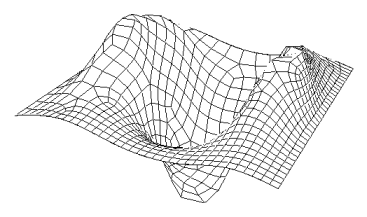Home > Mesh Generation > adaptivity and sizing functions > Linear Sizing Function
Cubit 15.9 User Documentation
The Linear class of sizing functions determines element size based on a weighted average of edge lengths for mesh edges bounding the surface being meshed. There are several variants of this class of sizing function. The Linear function bases edge length at a location on the lengths of edges bounding the surface weighted by their inverse distance from the current location. The result of this weighting is a more gradual change in mesh density during a transition between dense and coarse mesh. Figure 1 shows the same NURB surface mesh but with intervals of 34 on two curves and intervals of 16 on the remaining two bounding curves and no sizing function. It can be observed that the mesh progresses more rapidly inward from the coarser meshed curves, which locates the transition region much closer to the finer meshed curves. To combat this, the Linear function weights the sizing of new elements such that these transitions occur slower. Figure 2 displays two views of the same NURB geometry with the same bounding curve mesh density using the linear sizing function.

Figure 1. NURB mesh with no sizing function, 34 by 16 density


Figure 2. NURB mesh with linear sizing function, 34 by 16 density